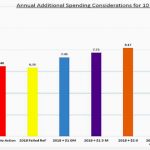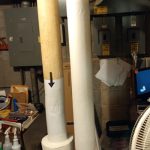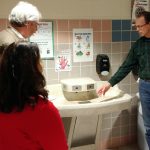Limited state funds strain district
By Scott Bellile
New London School District officials unveiled a proposed referendum they say is necessary to fix buildings that have been under-maintained.
“Our state funding in our district is well below that of other school districts, so that creates issues for us to have educational programs that are competitive with other districts. And then what happens? We have less for facilities and maintenance,” Superintendent Dennis Krueger told a crowd of about 20 attendees last week at Parkview Elementary School during the first of three listening sessions.
“We have significant facility, maintenance, safety, energy and efficiency-type needs identified in the district,” Krueger said.
Listening sessions were held Thursday, July 12 and Monday, July 16 to introduce the plan and collect taxpayers’ thoughts. A third session was set for after press time Wednesday, July 18 at 6 p.m. at New London Intermediate/Middle School.
The New London School Board has not voted to hold a referendum, decided on a dollar amount for a referendum, or finalized the list of facilities projects.
The district must declare the referendum at least 70 days before the election, which would be late August to appear on the Nov. 6 midterm election ballot.
District officials suggested a referendum of at least $15 million to address the most urgent facility needs.
Needs identified
The school board in January hired planning and architectural firm Unesco to study the district’s facilities and identify the biggest needs.
This referendum would not address them all, but district administrative staff and school board members highlighted some of the infrastructure that requires upgrades on Thursday, July 16.
High school and middle school boiler plants: New London High School was built in 1999 with 10 functional boilers. Today, just five are still functioning.
Windows: Parkview, Readfield and Sugar Bush elementary schools and New London Intermediate/Middle School all have single-pane windows, which are are less energy-efficient.
LED lighting: LED lights would be installed at the four elementary schools. NLHS upgraded to LED this past spring and expects to save $47,000 per year in energy costs.
Roofing system: Although the 2014 referendum funded roof repairs at three of New London’s schools, NLHS, Lincoln Elementary School and Sugar Bush still need maintenance.
Fire alarm systems: Business Services Director Joe Marquardt said the fire alarms work at the six schools but the technology is not up to date.
Air-handling units: Sugar Bush and Readfield still use air-handling units from the early 1960s while Parkview has one in place from 1982. Parkview and Readfield both received building additions, so their air-handling units are not connected throughout their entire facilities.
Restrooms: At most schools, restrooms could use improved accessibility for people with disabilities, and plumbing could be improved to ensure toilets and sinks work efficiently. Sinks at Lincoln are automated but their weak sensors are slow to respond to motion.
PA and clock systems at middle school: Clocks are not synced throughout NLIS/MS and can sometimes differ by four minutes.
An item that awaits a decision is whether to address space needs in Parkview’s entrance and gymnasium. The indoor space near the front doors can get crowded when students or families gather.
The gymnasium alternates between a physical education space and a cafeteria throughout the day, creating a time crunch around lunchtime for students and staff. Lunch tables are stored in the hallways, making halls narrow to walk through.
District officials concluded expanding the gymnasium toward Werner-Allen Road is not feasible due to underground utilities. Adding a flex room that could be a cafeteria on the southeast side of the school has been suggested.
Board member Chris Martinson has expressed opposition to this idea at school board meetings, saying he believes construction no longer counts as maintenance, and a referendum that involves additions could lose voters.
Timing with taxes
District officials said 2018 would be an opportune time to pass a referendum because taxpayers’ property taxes would decrease even if they approved it.
If voters passed a $15 million, 10-year referendum, then the mill rate – the amount in taxes homeowners pay per $1,000 of property owned – would drop 15 percent, from $9.16 per $1,000 owned in 2017-18, to $7.73 per $1,000 in 2018-19.
In other words, the owner of a $100,000 home would see his or her annual property taxes decrease from $916 to $773 if a referendum passed.
If a referendum failed, the mill rate would plummet to $6.35 per $1,000, a 30 percent decrease.
The School District of New London could have one of the lowest mill rates in the three counties it serves – Waupaca, Outagamie and Winnebago – whether or not a referendum passed. When compared to 2017-18 school year mill rates, the only districts’ mill rates that were lower than $7.73 last year were Freedom’s and Marion’s, according to Wisconsin Department of Public Instruction data.
The average mill rate in Wisconsin is $9.97.
Board member Mark Grossman said the steep drop in New London’s mill rate for the 2018-19 school year is the result of the district coming off of two major debts: outstanding payments on the 1999 construction of NLHS and a $2 million, four-year referendum voters approved in 2014 to fund security upgrades, roof repairs and literacy resources.
“This is really a good time to be looking at this with the debt load leaving us and being able to go ahead and make the improvements we need,” Grossman said.
Lack of adequate funding
The district has lost $44 million in revenue compared to average Wisconsin school districts since 1993, when the state legislature passed revenue limits in an effort to curb rising property taxes throughout the state, according to Marquardt.
“New London was a low-spending school district back at the time,” Marquardt said. “The school board wanted to make sure that they protected the investment of the taxpayers and were sure that we only had the money we needed. But with that, that locked us in at the amount of per-pupil spending that you could have. So if you were a higher-spending school district in that year, that continued on each year afterwards. If you were a low-spending school district, you locked yourself into that.”
Annually, the district has spent $1.7 million per student below the state average since 1993.
“It’s very challenging when you’re on the losing end of the equation for 20-some years and nobody [in the state legislature] wants to adjust it, although they know full well this is what was occurring,” New London School Board President Terry Wegner said.
“In the case of New London, we’ve been sending our money into the state and the state’s been sending it to districts that aren’t ours in some cases, so we’ve had a real challenge,” Wegner said.
The revenue limit comprises 90 percent of the school district’s revenues. A referendum is an option the district has to increase revenue limit authority. The money generated in a referendum could only be used locally, Wegner said.
Opinions
“We’ll never quite catch up if we don’t do something in a bigger scheme,” Wegner said. “We’ll just keep filling in the holes that need to be filled, and we’ll limp our way along doing the best we can for our students and for our staff and our community.”
Grossman said the district cares deeply about creating a proposal the public can support because if the referendum were to fail, then the state would take away from the district $100 per student for a total loss of $230,000.
A couple audience members questioned whether the public will have enough time to study the district’s proposal and form an opinion in the next few months.
Wegner expressed confidence in the district’s ability to reach the community, saying there is much more planned in the coming months to communicate with residents.
Local resident Seth Cowan addressed the school board Monday, July 16, to urge members to get buy-in from taxpayers, be transparent about the final project list, and plan well so another referendum will not be needed in the near future.
“Please try to find projects that will allow you to sustain your buildings and maintain them within the normal funding, so that we don’t have to keep coming back for more costs for things that have been allowed to deteriorate,” Cowan said.
To view the referendum listening session from Monday, July 16, visit the New London Access YouTube channel or keep an eye on the city’s public access television channel.



